Effects of chronic d-amphetamine administration on the reinforcing strength of cocaine in rhesus monkeys
- PMID: 20217052
- PMCID: PMC3122267
- DOI: 10.1007/s00213-010-1807-x
Effects of chronic d-amphetamine administration on the reinforcing strength of cocaine in rhesus monkeys
Abstract
Rationale: Agonist medications have been proven effective in treating opioid and nicotine dependence; results from clinical studies suggest that the indirect dopamine agonist d-amphetamine may reduce cocaine abuse. In preclinical studies, chronic d-amphetamine treatment decreased ongoing cocaine self-administration.
Objectives: The present study extended previous results by determining effects of chronic d-amphetamine treatment on the reinforcing strength of cocaine under conditions in which access to cocaine was suspended during d-amphetamine treatment.
Methods: Daily operant conditioning sessions consisted of morning access to food pellets delivered under a 50-response fixed-ratio schedule and evening access to cocaine (0.005-0.48 mg/kg per injection, i.v.) under a progressive-ratio schedule. After responding maintained by 0.045 mg/kg per injection cocaine stabilized, self-administration sessions were suspended and d-amphetamine (0.01-0.1 mg/kg per hr, i.v.) was administered continuously for 5 days. On the following day, d-amphetamine treatment was discontinued and daily self-administration sessions resumed.
Results: Following termination of d-amphetamine treatment, food- and cocaine-maintained responding was decreased in a dose-related manner. Decreases in the reinforcing strength of cocaine were larger and lasted longer than effects on food reinforcement. However, cocaine self-administration was unaltered if 6 days elapsed between discontinuation of d-amphetamine treatment and the next cocaine self-administration session.
Conclusions: The necessity of a self-administration session in the presence of d-amphetamine suggests that the protracted decrease in cocaine self-administration may be a manifestation of behavioral tolerance. Regarding treatment of cocaine dependence, data suggest that prolonged d-amphetamine treatment may be necessary to produce a sustained reduction in the reinforcing effects of cocaine.
Conflict of interest statement
The authors have no conflicts of interest to declare.
Figures



Similar articles
-
Effects of chronic d-amphetamine treatment on cocaine- and food-maintained responding under a progressive-ratio schedule in rhesus monkeys.Psychopharmacology (Berl). 2003 May;167(3):324-32. doi: 10.1007/s00213-003-1409-y. Epub 2003 Mar 22. Psychopharmacology (Berl). 2003. PMID: 12652348
-
Effects of chronic d-amphetamine treatment on cocaine- and food-maintained responding under a second-order schedule in rhesus monkeys.Drug Alcohol Depend. 2003 May 1;70(1):39-52. doi: 10.1016/s0376-8716(02)00339-3. Drug Alcohol Depend. 2003. PMID: 12681524
-
Prolonged attenuation of the reinforcing strength of cocaine by chronic d-amphetamine in rhesus monkeys.Neuropsychopharmacology. 2011 Jan;36(2):539-47. doi: 10.1038/npp.2010.185. Epub 2010 Oct 20. Neuropsychopharmacology. 2011. PMID: 20962765 Free PMC article.
-
How to make a rat addicted to cocaine.Prog Neuropsychopharmacol Biol Psychiatry. 2007 Nov 15;31(8):1614-24. doi: 10.1016/j.pnpbp.2007.08.028. Epub 2007 Aug 28. Prog Neuropsychopharmacol Biol Psychiatry. 2007. PMID: 17888555 Free PMC article. Review.
-
Psychological treatments for stimulant misuse, comparing and contrasting those for amphetamine dependence and those for cocaine dependence.Curr Opin Psychiatry. 2009 May;22(3):263-8. doi: 10.1097/YCO.0b013e32832a3b44. Curr Opin Psychiatry. 2009. PMID: 19307968 Free PMC article. Review.
Cited by
-
Methamphetamine Cured my Cocaine Addiction.J Addict Res Ther. 2010 Oct 14;1(103):1000103. doi: 10.4172/2155-6105.1000103. J Addict Res Ther. 2010. PMID: 23066512 Free PMC article.
-
Agonist Medications for the Treatment of Cocaine Use Disorder.Neuropsychopharmacology. 2015 Jul;40(8):1815-25. doi: 10.1038/npp.2014.322. Epub 2014 Dec 11. Neuropsychopharmacology. 2015. PMID: 25563633 Free PMC article. Review. No abstract available.
-
The individual and combined effects of phenmetrazine and mgluR2/3 agonist LY379268 on the motivation to self-administer cocaine.Drug Alcohol Depend. 2016 Sep 1;166:51-60. doi: 10.1016/j.drugalcdep.2016.06.020. Epub 2016 Jun 25. Drug Alcohol Depend. 2016. PMID: 27394931 Free PMC article.
-
A Single Amphetamine Infusion Reverses Deficits in Dopamine Nerve-Terminal Function Caused by a History of Cocaine Self-Administration.Neuropsychopharmacology. 2015 Jul;40(8):1826-36. doi: 10.1038/npp.2015.45. Epub 2015 Feb 18. Neuropsychopharmacology. 2015. PMID: 25689882 Free PMC article.
-
Pharmacological validation of a translational model of cocaine use disorder: Effects of d-amphetamine maintenance on choice between intravenous cocaine and a nondrug alternative in humans and rhesus monkeys.Exp Clin Psychopharmacol. 2020 Apr;28(2):169-180. doi: 10.1037/pha0000302. Epub 2019 Jul 1. Exp Clin Psychopharmacol. 2020. PMID: 31259593 Free PMC article.
References
-
- Ator NA, Griffiths RR. Principles of drug abuse liability assessment in laboratory animals. Drug Alcohol Depend. 2003;5:S55–S72. - PubMed
-
- Barrett AC, Miller JR, Dohrmann JM, Caine SB. Effects of dopamine indirect agonists and selective D1-like and D2-like agonists and antagonists on cocaine self-administration and food maintained responding in rats. Neuropsychopharmacology. 2004;47 Suppl 1:256–273. - PubMed
-
- Beckett AH, Rowland M. Urinary excretion kinetics of amphetamine in man. J Pharm Pharmacol. 1965;17:628–639. - PubMed
-
- Carroll FI, Howell LL, Kuhar MJ. Pharmacotherapies for treatment of cocaine abuse: preclinical aspects. J Med Chem. 1999;42:2721–2736. - PubMed
-
- Castells X, Casas M, Vidal X, Bosch R, Roncero C, Ramos-Quiroga JA, Capella D. Efficacy of central nervous system stimulant treatment for cocaine dependence: a systematic review and meta-analysis of randomized controlled clinical trials. Addiction. 2007;102:1871–1887. - PubMed
Publication types
MeSH terms
Substances
Grants and funding
LinkOut - more resources
Full Text Sources
Medical

